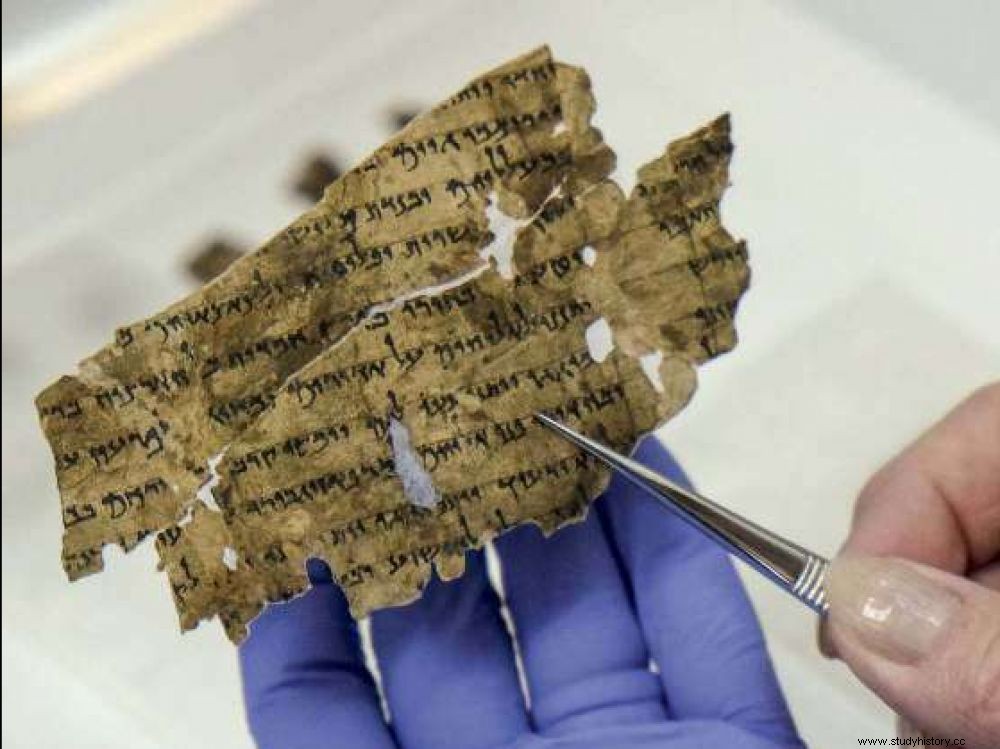In 1947, the discovery of the Dead Sea Scrolls, hidden in jars themselves hidden in caves, aroused many fantasies. A story far from over.

Alongside almost complete scrolls, archaeologists have gotten their hands on nearly 25,000 fragments of manuscripts which they are reconstructing (here, by sewing them together) thanks to the DNA of the skins used.
This article is from the magazine Sciences et Avenir - Les Indispensables n°206, dated July/September 2021.
Legend has it that a kid lost in a cave in the Judean desert was the source of one of the most spectacular archaeological discoveries of the 20th century:that of the Dead Sea Scrolls. The oldest surviving manuscripts of the Hebrew Bible. If the reality turns out to be a little more complex, it is still partly due to chance.
A few months later, four other scrolls were in turn exhumed
In 1947, it was indeed in caves, near Khirbet Qumrân (in Arabic "the ruin of Qumrân"), that Bedouins of the Ta'amireh tribe unearthed ancient parchments, some kept in large jars, and which will be called the Great Scroll of Isaiah, the Rule of the Fellowship and the Commentary of Habaquq. Skins whose value they do not know. A few months later, four other parchments were unearthed:a second Scroll of Isaiah, the rules of the War, the Hymns and the Apocryphon of Genesis.
The adventure of these texts has only just begun! Two years later, and while the first Arab-Israeli conflict, following the creation of the Jewish state, set the region ablaze, archaeologists from the Department of Antiquities of Jordan, the Palestine Archaeological Museum and the School Bible of Jerusalem learn of the existence of manuscripts found on the side of the Dead Sea.
This article is from the magazine Sciences et Avenir - Les Indispensables n°206, dated July/September 2021.
Legend has it that a kid lost in a cave in the Judean desert was the source of one of the most spectacular archaeological discoveries of the 20th century:that of the Dead Sea Scrolls. The oldest surviving manuscripts of the Hebrew Bible. If the reality turns out to be a little more complex, it is still partly due to chance.
A few months later, four other scrolls were in turn exhumed
In 1947, it was indeed in caves, near Khirbet Qumrân (in Arabic "the ruin of Qumrân"), that Bedouins of the Ta'amireh tribe unearthed ancient parchments, some kept in large jars, and which will be called the Great Scroll of Isaiah, the Rule of the Fellowship and the Commentary of Habaquq. Skins whose value they do not know. A few months later, four other parchments were unearthed:a second Scroll of Isaiah, the rules of the War, the Hymns and the Apocryphon of Genesis.
The adventure of these texts has only just begun! Two years later, and while the first Arab-Israeli conflict, following the creation of the Jewish state, set the region ablaze, archaeologists from the Department of Antiquities of Jordan, the Palestine Archaeological Museum and the School biblical Jerusalem learn of the existence of manuscripts found near the Dead Sea. The appearance of a small photograph published in an American magazine caught their attention. These scholars remember ancient testimonies of the Church Father Origen (3rd century) and his pupil Eusebius of Caesarea, who already mentioned (non-biblical) manuscripts found in caves around Jericho. Real expeditions will then be mounted, in difficult conditions, since there is then no road to reach Qumran. But persistence will pay. The archaeologists of the Biblical School of Jerusalem end up finding the first caches. These are located in the steep cliffs of the western shore of the Dead Sea, in Jordanian territory. Between 1949 and 1956, eleven caves housing more than 900 biblical manuscripts and thousands of fragments were thus located.
Scroll elements related to the twelve minor prophets
Until these exceptional discoveries of the 20th century, only medieval rabbinic texts and a translation of the Hebrew Bible into Greek, called the Septuagint, were known to scholars. With the Dead Sea Scrolls, everything changes. Scientists find themselves for the first time in possession of original religious texts, written in Hebrew by Jewish communities, which propels them suddenly to the true origins of the Book… more than two thousand years ago! In the same way they discover apocryphal texts - not retained thereafter in the canon of the Hebrew Bible. All the documents, dated to the 3rd century BC. J. -C. in the 1st century of our era, are today under the responsibility of Israel, and, for the most part, preserved in Jerusalem, in the Sanctuary of the Book (Heykhal ha-Séfèr). But the story of these discoveries does not seem to want to stop… In 2020, a cave located in the Nahal Hever nature reserve, near Hebron, delivered elements of parchments linked to the twelve minor prophets of the Bible. The first biblical fragments officially found for… sixty years!
